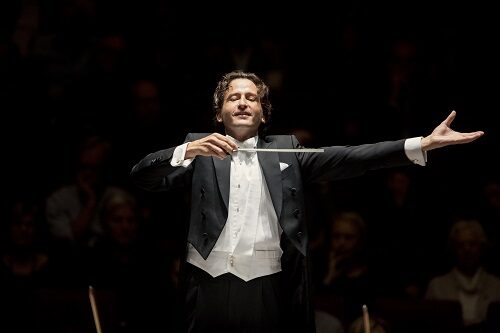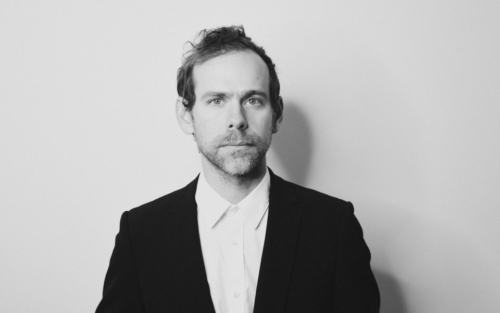 United States Ravel, Bryce Dessner, Franck: Katia and Marielle Labeque (pianos), Cleveland Orchestra / Gustavo Gimeno (conductor). The Jack, Joseph and Morton Mandel Hall at Severance Music Center, Cleveland, Ohio, 26.11.2021. (MSJ)
United States Ravel, Bryce Dessner, Franck: Katia and Marielle Labeque (pianos), Cleveland Orchestra / Gustavo Gimeno (conductor). The Jack, Joseph and Morton Mandel Hall at Severance Music Center, Cleveland, Ohio, 26.11.2021. (MSJ)

Ravel – Mother Goose, Suite
Bryce Dessner – Concerto for Two Pianos
Franck – Symphony in D minor
The Cleveland Orchestra continues to blaze this season, offering the local premiere of a concerto by an intriguing living composer and a masterful rendition of a tricky classic – a vital spark that’s precious and needed these days.
Bryce Dessner is known to some (including me) through his work in the rock band The National. Others know him from the soundtrack he wrote for the film The Revenant. On display in this concert was Dessner’s Concerto for Two Pianos, written for – and played here by – his friends Katia and Marielle Labeque. Sampling the first two genres shows Dessner’s wide and enterprising range, but this concerto gives a fuller picture of a musical mind teeming with energy.
The concerto opens with a bang, emphasized by a percussion slapstick, as the pianists unfurl cascading runs. It is a sound-world aware of past orchestral music, particularly minimalism, but it’s far more fragmentary in gesture. The work settles down to quietly present a four-note motif (usually harmonized in chords) that returns throughout the movement. But things never remain quiet for long, with even the softest moments prone to being skewered by a sudden thump from one of the pianos or a stabbed tremolo from the strings. All three movements are restless.
With its low pedal tones in the brass, the opening movement has moments of what feel like a spacious vista, but the view is always undercut by the nervous chatter of the pianos, which struck me as an apt reflection of our media-saturated world. On first hearing, the sheer amount of chatter makes it hard to absorb and sort this music on the fly, but its excitement is attractive, and the Labeque sisters threw themselves into it with ferocious attack, sparring back and forth and with the orchestra, led with alacrity by guest conductor Gustavo Gimeno. Without escaping its nervousness, the movement closes in an uneasy calm.
Rhythm and harmony figure more highly than melody in this work, even in the second movement. It starts quietly, but with an insistent ticking pulse. The pianos enter with nervous filigree, accompanied by sinking strings against the unceasing pulse. That beat becomes less regular and new growth quickly emerges from both soloists and orchestra. This ‘slow’ movement soon grows rife with the same restlessness that permeates the outer movements, building enormous energy that kinetically erupts into the third movement, the largest in the work.
It begins with racing figurations in the pianos, propelled by a snare drum, that cause the music to take flight in a flurry of sparks. The relentless current calms some without slowing as the middle of the movement is approached. Suddenly, there is a moment of breathtaking silence, then the pianos enter with simple, quiet chords. The feeling of emotional release is as tremendous as it is precarious. Soon, glittering trickles of sound return in the upper register of the pianos, followed by the return of rhythmic drive in the orchestra, now more syncopated and dancing than before. Focus achieved at last, it hurtles with exhilaration toward a closing that mixes chords ambiguously, refusing to resolve.

Dessner’s concerto received an instant standing ovation from the appreciative audience. The Labeques returned for a bonus, which turned out to be one of their long-favored encores, the ‘Jet Song’ from Leonard Bernstein’s West Side Story, in a boogie-woogie arrangement by Irwin Kostal.
With so much energy hovering around the concerto, one might think that the symphony after intermission would come as an anticlimax, but nothing could be further from the truth. César Franck’s Symphony in D minor was once a popular work, played frequently and well. Then, for some reason, it mostly fell out of the repertory and has become a relative rarity today.
The reason? I’d say it was because the ability to conduct it well disappeared. Some works are indestructible, no matter how they are performed. Not so this one. Franck had grand ideas that he pursued in this work, but he was by no means the kind of composer who can make his music live on the printed page. Franck, an organist by trade, was accustomed to using full textures in his playing, which doesn’t always transfer ideally to orchestral writing. And the fact that Franck was bringing a strong Wagnerian influence into the Gallic style of writing music makes his position even more precarious. Nonetheless, he was able to initiate a personal tradition by conducting the work himself at the 1888 premiere in Paris, which later disciples continued, leading the public to gradually warm up to and embrace this lovable piece.
But Franck requires a lot of nuance and shaping, two things that fell out of fashion in the mid-twentieth century, when the gospel of literalism cast its glum stare over everything. And with literalism in a score that really only suggests Franck’s flights of imagination instead of spelling it out, the skill of conducting Franck began to falter. The early twentieth century had seen conductors such as Beecham, Munch, Paray and Mengelberg leading compelling performances, but the work began to suffer in stiffer, more literal performances. The last great rendition came from Pierre Monteux in 1961 with the Chicago Symphony.
After that, it seemed the gift of conducting Franck was lost. Herbert von Karajan handled the work heavily, as if Franck’s being an organist meant his music should be treated like Bruckner. Stiff, literal readings deadened the work in recordings throughout the late twentieth century. Leonard Bernstein tried to counter the leadenness of modern performances, but he went too far in the other direction, pulling tempos around like taffy. In 1995, in a performance preserved in an outstanding box set released by the Cleveland Orchestra, then-music-director Christoph von Dohnányi tried to temper the squareness of literalism with a handsome orchestral glow, with some success.
The last time the Franck was performed here was in 2013, under the direction of Marek Janowski. Janowski is another literalist, albeit one with a sensitivity toward the need to keep Franck’s textures clear. His performance was satisfying enough, but it didn’t quite get inside the music. I remember feeling at the time that I’d never hear Franck conducted like Monteux or Paray did. The art of conducting Franck’s D minor symphony seemed to have died off.
I’m delighted to report that I was wrong. Gustavo Gimeno surprised me with a masterful, vintage rendition of the piece, the first performance in decades that stands direct comparison to the ‘old masters’. One could examine this performance for thousands of details, and show how Gimeno worked with soloists and sections to bring shape and personality to the music, making it feel personal where others supply only vague grandeur.
Yet at the same time, Gimeno displayed impeccable taste, avoiding some of the overwrought traditions which Monteux only barely manages to sell in his recording, such as the big slowdown into the coda of the first movement. Instead of handling that moment like a parody of tradition (Bernstein) or stoically literal (Janowski), Gimeno gave it just the slightest easing of tempo into the broader coda, which was perfect.
Robert Walters was haunting in the English horn solo in the second movement, and he was given space to be flexibly expressive despite the flowing tempo. All the woodwinds were glorious throughout the symphony, and Gimeno made sure that their colors weren’t swamped by other sections. He also showed a sure hand at building the excitement near the end of the symphony without superficially speeding up. It was the performance I’d always dreamed of hearing yet never thought I would.
If there was one thing in the concert that was less compelling, it was the opening Mother Goose suite of Ravel. The performance was good, beautifully played, but it didn’t erase memories of Mathias Pintscher’s 2018 performance, which somehow got more inside the notes. Perhaps the sheer work of introducing the Dessner and revivifying the Franck precluded an in-depth plunge into the Ravel as well. Regardless, the other two works blazed, another in the recent string of outstanding concerts from Cleveland.
Mark Sebastian Jordan
